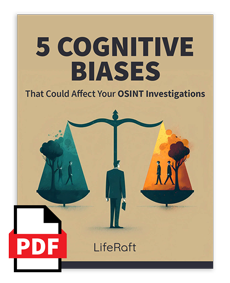Open source intelligence (OSINT) is a valuable tool in a security team’s toolbox. Initially pioneered by the CIA during World War II as a strategy to gain intelligence from public sources worldwide, today, OSINT has become instrumental for the safe functioning of governments, militaries, organizations, and companies of all sizes and industries.
But how does OSINT work, and what does an intelligent security strategy entail? How can OSINT protect a business or organization?
Answering these questions starts with an understanding of the fundamentals of open source intelligence, why it's become so crucial for businesses to understand, and some practical ways companies can utilize it for their benefit.
Learn More: 5 Cognitive Biases That Could Affect Your OSINT Investigations
What is OSINT?
Open source intelligence refers to collecting public data to provide decision-makers with actionable insights and information. Several decades ago, OSINT referred to gathering data from primarily printed materials, like newspapers, pamphlets, books, or magazines, but in our modern era, this definition has dramatically expanded.
There are an estimated 5.16 billion internet users worldwide as of January 2023, and collectively, these users upload terabytes of content to the internet daily. In today’s environment, a successful OSINT strategy entails combing through countless websites, digging deep into social media platforms, message boards, blogs, classifieds pages or sites, and dark web sources. This data is virtually endless, but the goal is to find that needle in a haystack that indicates a possible threat, invaluable information, or a new challenge or opportunity for a specific company or organization.
When appropriately executed, OSINT has the power to avert a problem that can easily spiderweb into a significant crisis, which is why governments, organizations, and Fortune 500 companies around the globe have adopted it as their primary security strategy.
In a recent article by the Harvard International Review, OSINT was heralded as “The Untapped Treasure Trove of United Nations Organizations" precisely because of how it assisted the World Health Organization (WHO) with identifying potential outbreaks for nearly two decades. In one famous example, the WHO detected an “unusual respiratory illness” in the Chinese Guangdong Province in November 2002, eventually leading to a global warning and prevention measures against the newly identified Acute Respiratory Syndrome (SARS). Ironically and unfortunately, this same strategy that detected SARS was shut down in May 2019, months before the onset of Covid-19. Questions remain about whether the system could have wholly prevented the multi-year pandemic or at least could have minimized it like the SARS outbreak.
Preventing worldwide health crises or global emergencies, like military attacks, coups, or riots, are some of the more extreme and publicized uses of OSINT. Still, open source intelligence quietly helps institutions in the private and public sectors daily.
From ensuring brand protection to monitoring events that can affect a company's supply chain, OSINT can prevent major and minor disasters or disruptions and save an organization time, money, and resources in countless ways.
Helping to avert disaster is especially helpful for privately-owned businesses and corporations, who lack access to the same security resources as a national government or the World Health Organization.
How can OISNT help protect your organization?
Executive Security

When a business’s top executives travel, make public appearances, or head to the office; chances are that security teams are poised to react to any oncoming threats. In other words, guards or security teams will respond if a threat is in process, but they have no way of knowing ahead of time if an attack is imminent.
In the above scenarios, OSINT takes a proactive approach to security, not a reactive one. Before an attack or crisis occurs, there are generally online clues that a threat is on the horizon. Open source intelligence can pinpoint these threats to high-profile individuals well before it becomes active. Because bad actors target company leaders and high-profile personnel in-person or online, OSINT is essential to any security strategy to keep a business' most valuable team assets safe.
In addition, OSINT can identify and address broader security issues beyond the immediate threat of a personal attack. For example, after Hurricane Marina in 2017, a team of Microsoft Executives almost canceled a trip to Puerto Rico after a wave of alarming news reports and news footage. Instead of canceling, they used OSINT to receive detailed plans and assessments for their upcoming trip, ensuring safe travels and business operations throughout the region.
IP Protection
One of the most valuable assets that an organization has is its brand. A strong brand evokes a promise of exceptional services and products. However, brand protection is becoming a steadily rising issue in our modern era. Criminals and bad actors utilize an established brand to create counterfeit products, engage in piracy and illegal streaming, attack a company's reputation, and effectively blemish a company's reputation.
OSINT can identify these bad actors and illegal operations, saving the company money in actual products or services and the untold costs of losing brand loyalty.
Crisis Response
 Businesses can be impacted in several ways when a natural or manufactured crisis hits a small corner of the globe. For one thing, a slow crisis reaction time can mean accelerated and debilitating costs in damages and service disruptions. More importantly, a slow response can endanger the lives of customers, clients, and employees.
Businesses can be impacted in several ways when a natural or manufactured crisis hits a small corner of the globe. For one thing, a slow crisis reaction time can mean accelerated and debilitating costs in damages and service disruptions. More importantly, a slow response can endanger the lives of customers, clients, and employees.
A natural or manmade disaster can strike anywhere in the world. Getting real-time information from an area without power, internet, cell service, and other utilities is challenging at best when this occurs. As a result, social media and small online sources are usually at the front of what's happening on the ground. They can provide information hours, if not days, before international news outlets pick up the details.
An example was Hurricane Dorian in September 2019. This storm devastated a small island community off the coast of North Carolina. It wasn't until reports of the extensive damage surfaced on social media and small local newspapers that the Governor issued evacuation orders to rescue residents in more than 7 feet of water.
Ultimately, OSINT saves security teams valuable time and can alert a business when an immediate response is required or when the coast is clear.
Data Leaks
 Since the shift to remote work during the Coronavirus pandemic, and an increased reliance on web-based tools to stay connected, data leaks are more of a threat than ever.
Since the shift to remote work during the Coronavirus pandemic, and an increased reliance on web-based tools to stay connected, data leaks are more of a threat than ever.
Data leaks can threaten organizations continuously, as a criminal only needs a small opening – like a picture of a work badge, or a few key employee details garnered from a Facebook page – to gain broad access to a company. OSINT can prevent data leaks, as it doesn't just look for outside threats – it also looks internally for any missteps or accidental data sharing to ensure that a business is protected from the inside out.
Due diligence and risk analysis for smarter decisions
OSINT is not limited to security risks, like potential threats at large events or to executives and employees. It can also provide proactive information that can help guide smarter decisions. For example, with open source intelligence, a company can conduct due diligence to ensure that a new customer, partner, employee, supplier, or other outsourced service provider is on the level and has no history of shady business dealings.
OSINT can also capture chatter and trends regarding a particular market or region that may affect a new project or territory. It can also identify potential supply chain issues- like the scarcity of a specific material used in a product.
Simply put, OSINT puts a wealth of information at the decision-makers’ fingertips in the arenas where extensive data is needed the most. From future ambitions to ongoing operations, OSINT helps shape a better blueprint for the future.
How can a Business Conduct an Intelligent OSINT Strategy?
It starts with an experienced partner.
Most companies and organizations, regardless of size, don't have the capacity or the resources to monitor every corner of the internet 24/7 to find threats and identify opportunities. The impossibility of human monitoring is why the best way to incorporate an extensive OSINT operation is to work with an experienced and reputable partner.
LifeRaft's threat intelligence and investigations platform has guided organizations of all varieties, from mid-size businesses to Fortune 500 companies. Our Navigator product is the most innovative tool on the market, combining automation, data visualization, and validation processes to bolster intelligence capabilities across the board.
Enlisting an OSINT expert is an effortless way to save time, productivity, and costs and safeguard against emergencies without expending countless security team resources.
The Bottom Line on OSINT
Businesses continue to learn about OSINT and the powerful ways it can help protect their companies. OSINT offers tangible opportunities for finding, understanding, and leveraging information more efficiently to protect against threats. By monitoring open sources for potential risks and adversary activities, companies can react quickly and effectively if any security threats arise. For businesses looking for a comprehensive platform to make OSINT easier and more worthwhile for their teams, consider working with a reputable provider.
Connect with us today, and let’s start a conversation about your organization’s most immediate concerns, long-term goals, and how LifeRaft can help pave the way for a safer and more prosperous future.

